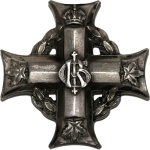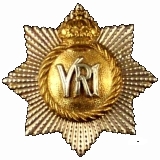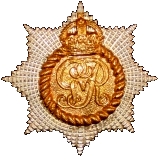
The Royal Canadian Regiment and
The First World War - 1914-1919

Re-Visiting the Great War Roll of Honour for The RCR
By Captain Michael M. O'Leary, The RCR
"Once a Royal Canadian, Always a Royal Canadian." This long held tenet of our Regiment has been clearly demonstrated by the honour and care shown by the Regiment when casualties of our war in Afghanistan have included not only soldiers badged into The RCR but also soldiers posted into regimental Battle Groups from other units and Branches of the CF. But this has not always been the case.
Within Volumes I and II of the regimental history, one finds the annexes comprising the casualty lists of each of the Regiment's periods of wartime service. At first glance they might appear to be comprehensive, but more recent research has found omissions in the lists for the First and Second World Wars and for Korea. It also becomes apparent with closer examination that the original published lists, though incomplete probably due mostly to the difficulties of compiling research in a pre-digital age, also were limited to only those Royal Canadians who died while serving with the applicable overseas unit. Oddly, this meant that the Regiment, for example, did not include Brigadier John Kelburne Lawson as one of our fallen in the 1966 volume after he died commanding Canadian troops in Hong Kong. Brigadier Lawson had begun his service with The RCR in 1923, having previously served during the Great War during which he was awarded the Military Cross while serving with the Canadian Machine Gun Corps.
This selective approach to recording our regimental casualties has resulted in losing connections to many others over the course of our history and to the families that also suffered their loss. "Once a Royal Canadian …" is often quoted to suggest that once someone has served with The RCR, they are obliged to remember that service and always be proud of it. I would suggest that obligation is a two-way street, and that one of the unwritten regimental obligations of "Once a Royal Canadian …" is also to remember that some who served in or with the Regiment went on to serve in other units and some died wearing another cap badge; though by our own dictum they remain "Royal Canadians." A signal example of this can also be found in our stories of the Second World War.
Lieutenant John Blair Hunt landed in Sicily as the Regiment's Intelligence Officer at Pachino. In late 1943 he was wounded, and on recovery was sent to the PPCLI with whom he was killed at San Leonardo on 14 Dec 1943. Regimental histories for both The RCR (Vol. 2, Stevens, 1967) and the PPCLI (Vol III, Stevens, 1957) agree in their texts that Lieut. Hunt had "been loaned by The Royal Canadian Regiment as a company commander two days before" when he was killed in action (quoted from PPCLI Vol III, p. 133). Despite this, Lieut. Hunt is officially recorded as a casualty of the PPCLI and was not recorded as a regimental casualty in our Regiment's Roll of Honour.
Although the examples above are both from the Second World War and are of officers of the Regiment, they will be known to some readers and do effectively demonstrate that the selective method of placing names on the Regiment's early Rolls of Honour was not only applied to lower ranks. It affected all equally, as it did in the case of Private Henry Krimmell who, while he would even have still been wearing the eight-pointed star, was serving with the 7th Light Trench Mortar Battery at the time of his death.
There are, in fact, 39 officers, NCOs and soldiers of the First World War who served with The RCR in the field and later died while on the strength of other units. Some of these men, like Krimmel, were RCR soldiers who had been posted to other units without a change of parent regiment. Others were initially soldiers of The RCR and later changed both units and badges. Still others spent periods with the Regiment for familiarization in the trenches or while awaiting commissioning, and still more were taken on the strength of The RCR only to be transferred again days or weeks later to another front line unit as the reinforcement system struggled to make up and balance losses.
But each of these soldiers has one common attribute. They were each on the strength of The RCR, either posted into the unit or attached, for a brief period. And each later died; a Canadian casualty of the Great War. The list that follows contains the names of these Royal Canadians, however brief their regimental service.
Permanent Force Soldiers of the Regiment
The RCR started its service in the First World War tasked as the garrison battalion in Bermuda. Upon return to Halifax and subsequent preparations for sailing to England, some soldiers of the Regiment did not continue overseas with the Regiment at that time, but continued their service with other units. Others completed the voyage to England but were transferred out of the Regiment before it entered the trenches in France.
- 478824 Pte Isaac Stephen Burns. Died 27 Aug 1916 while serving with the 193rd Canadian Battalion. RCR service from 29 Mar 1884 to 25 Aug 1915. (Permanent Force No. 2095, enlisted in the Regiment 29 Mar 1884.)
- 2228308 Sgt Joseph Marcil. Died 19 May 1921 while serving with the Canadian Forestry Corps. RCR service from 6 Dec 1912 to 24 Aug 1915. (Permanent Force No. 8260, enlisted in the Regiment 6 Dec 1912.)
- 7620 Pte Arthur Francis Nanfan. Died 10 Aug 1918 while serving with the 2nd Battalion, Canadian Mounted Rifles. RCR service from 17 May 1909 to 8 Aug 1915. (Permanent Force No. 7620, enlisted in the Regiment 17 May 1909.)
- 477753 Spr Thephold Eddie Quintin. Died 9 Apr 1917 while serving with the 8th Field Company, CE. RCR service from 27 May 1914 to 21 Oct 1915. (Permanent Force No. 8595, enlisted in the Regiment 27 May 1914.)
- 401080 Pte Henry Croahelm Tobias. Died 27 Sep 1918 while serving with the 2nd Canadian Infantry Battalion. RCR service from 22 Feb 1907 to (tbc). (Permanent Force No. 7435, enlisted in the Regiment 22 Feb 1907.)
Recruited into The RCR, but did not serve in France with the Regiment
During the First World War, The RCR continued to enlist soldiers into the Permanent Force at its Canadian Garrison. Some of these soldiers joined reinforcement drafts formed to join the overseas battalion, but not all reached The RCR in the field.
- 478997 Pte William James Ivy. Died 29 Sep 1917 while serving with the 2nd Canadian Labour Battalion. Sailed from Canada as a soldier of the RCR Reinforcement Draft of 3 Oct 1916.
- 478975 Pte Frederick Alfred Lake. Died 10 Apr 1917 while serving with the PPCLI. Sailed from Canada as a soldier of the RCR Reinforcement Draft of 3 Oct 1916.
The Light Trench Mortarman
Three soldiers of the Regiment died while serving with the 7th Brigade's Light Trench Mortar Battery. Infantry soldiers serving in the T.M. Battery continued to wear their parent regiment's cap badge.
- 401417 Cpl Robert Christofferson. Died 23 Oct 1918 while serving with the 7th L.T.M. Bty. RCR service from 8 May 1916 to 1 Oct 1917.
- 477501 Pte Herbert William Krimmel. Died 4 Apr 1918 while serving with the 7th L.T.M. Bty. RCR service from 13 Oct 1915 to 1 Oct 1917. (Permanent Force No. 12217, enlisted in the Regiment 13 Oct 1915.)
- 261232 Pte Archibald J Wylie. Died 30 Oct 1917 while serving with the 7th L.T.M. Bty. RCR service from 3 Nov 1916 to 1 Oct 1917.
Served in France and Flanders with The RCR
- 477386 Spr Luke Hayes. Died 15 Nov 1918 while serving with the 5th Battalion, Canadian Railway Troops. RCR service from 31 Oct 1914 to 4 Oct 1916. (Permanent Force No. 16347, enlisted in the Regiment 31 Oct 1914.)
- 733096 Cpl Frank Heffernan. Died 6 Jul 1918 while serving with the 1st Tram Company, Canadian Engineers. RCR service from 26 Apr 1917 to 23 Nov 1917.
- 406908 Pte William Houghton. Died 20 May 1918 while serving with the 7 Canadian General Hospital. RCR service from 8 Oct 1915 to 5 Dec 1917.
- 715379 Pte William James Huggan. Died 13 May 1918 while serving with the 2nd Canadian Infantry Works Battalion. RCR service from 9 Feb 1917 to 14 Apr 1917.
- 461188 Pte Lawrence Edward Keir. Died 24 Mar 1918 while serving with the Borden Motor Machine Gun Battery. RCR service from 8 Jun 1916 to 30 Jul 1916.
- 440375 Pte John Kinnell. Died 20 Jun 1918 while serving with the 1st Canadian Infantry Works Battalion. RCR service from 8 Jun 1916 to 22 Sep 1916.
- 441918 Cadet William Francis Lewin. Died 15 Jul 1917 while serving with the PPCLI. RCR service from 8 Jun 1916 to 10 Jul 1916.
- 877934 Pte Neil Joseph McNeil. Died 24 Sep 1918 while serving with the 3rd Battalion, CMGC. RCR service from 11 Mar 1918 to 27 Mar 1918.
- 817505 Pte William Alexander Miller. Died 6 Oct 1918 while serving with the 43rd Canadian Infantry Battalion. RCR service from 30 Nov 1916 to 26 Aug 1918.
- Lieut. Layland Ashwell Naylor. Died 7 Jul 1919 while serving with the RAF. RCR service from 18 Jun 1916 to 6 Oct 1917. 2005007 Pte Albert Martin Neiforth. Died 30 Sep 1918 while serving with the 4th Bn, CMGC. RCR service from 23 Feb 1918 to 13 May 1918.
- 709059 Pte Stanford Richard Sloat. Died 22 Dec 1918 while serving with the 2nd Coy, Canadian Forestry Corps. RCR service from 1 Dec 1916 to 24 May 1918.
- 898291 Pte George Harvey Tennant. Died 30 Oct 1917 while serving with the 49th Canadian Infantry Battalion. RCR service from 26 Jun 1917 to 6 Aug 1917.
- 425425 Pte Raymond Sydney Townsend. Died 14 Feb 1919 while serving with the 27th Coy CFC. RCR service from 8 Jun 1916 to 8 Oct 1916.
- 101063 Pte Oliver Mardon Tulk. Died 12 Apr 1917 while serving with the 15th Machine Gun Company, CMGC. RCR service from 8 Oct 1915 to 17 May 1916.
Attached for Training
The following officers and soldier were attached to The RCR in the field in advance of their later commissioning (or intent to be commissioned).
- Lieut. Alexander Daniel Fraser. Died 7 Nov 1917 while serving with the 85th Canadian Infantry Battalion. Attached to The RCR from 25 Feb 1917 to 27 Mar 1917.
- 2473 Pte George Leslie Graham. Died 2 Dec 1917 while serving with the Lord Strathcona Horse. Attached to The RCR from 1 May 1917 to 6 Jun 1917.
- Lieut. Clifford C Henderson. Died 2 Sep 1918 while serving with the 75th Canadian Infantry Battalion. Attached to The RCR from 30 Mar 1917 to 11 Jun 1917.
- Lieut. Francis John Howley. Died 6 Dec 1917 while serving with the 7th Stationary Hospital, CAMC. Attached to The RCR from 2 Mar 1917 to 16 Apr 1917.
- Capt Harold Jackman. Died 21 Mar 1918 while serving with the 7th Battalion, King's Royal Rifle Corps of the British Army. Attached to The RCR from 14 Jul 1916 to 6 Aug 1916.
- Maj. Lynus Dalbert Jones. Died 14 Jan 1920 while serving with the 2nd Infantry Base Depot. Attached to The RCR from 1 Dec 1916 to 6 Jan 1917.
A very short service group; 5 days with The RCR
On 6 Sep 1918, 111 soldiers were taken on the strength of the Regiment in France as reinforcements although the Regiment's War Diary does not indicate that they actually reached the unit in the field. Five days later, on 11 Sep 1918, 95 men were struck off strength, of these 48 went to the 2nd Canadian Infantry Battalion and 47 went to the 85th Canadian Infantry Battalion. Eight of these men, who for a few days served in The Royal Canadian Regiment, became casualties of the Great War. These soldiers all served with the Regiment from 6 Sep 1918 to 11 Sep 1918.
- 3180572 Pte Leslie James Colbourne. Died 28 Sep 1918 while serving with the 85th Canadian Infantry Battalion.
- 3180935 Pte John Daley. Died 6 Nov 1918 while serving with the 85th Canadian Infantry Canadian Infantry Battalion.
- 3180802 Pte Fred Burton Faulkner. Died 22 Oct 1918 while serving with the 85th Battalion.
- 3181113 Pte Malcolm Norman Ferguson. Died 29 Sep 1918 while serving with the 85th Canadian Infantry Battalion.
- 3180867 Pte Thomas Francis Hawes. Died 25 Sep 1918 while serving with the 85th Canadian Infantry Battalion.
- 3180298 Pte Rodney Harrington Lantz. Died 27 Sep 1918 while serving with the 2nd Canadian Infantry Battalion.
- 3180956 Pte Lockie (Lauchlin) Mailman. Died 27 Sep 1918 while serving with the 2nd Canadian Infantry Battalion.
- 1263403 Pte Edward Rouse. Died 17 Feb 1919 while serving with the 2nd Canadian Infantry Battalion.
The above list, however, still fails to include those prior serving soldiers, NCOs and officers of The RCR who left the Regiment in Canada and transferred to or reenlisted in other units for their wartime service. Sadly, we may never be certain we have identified all such Royal Canadians, but this list does add a few more names to our Roll of Honour who deserve to have their service with The RCR remembered; however brief it may have been.
Pro Patria
- The O'Leary Collection; Medals of The Royal Canadian Regiment.
- Researching Canadian Soldiers of the First World War
- Researching The Royal Canadian Regiment
- The RCR in the First World War
- Badges of The RCR
- The Senior Subaltern
- The Minute Book
- Rogue Papers
- Tactical Primers
- The Regimental Library
- Battle Honours
- Perpetuation of the CEF
- A Miscellany
- Quotes
- The Frontenac Times
- Site Map

![]() The RCR in the Great War
The RCR in the Great War
![]() War Diary
War Diary
![]() Battle Honours
Battle Honours
![]() Battle Bars and The RCR
Battle Bars and The RCR
![]() The RCR Battle Bar Ledger (pdf)
The RCR Battle Bar Ledger (pdf)
![]() Honours and Awards
Honours and Awards
![]() Roll of Honour
Roll of Honour
![]() Prisoners of War
Prisoners of War
![]() Cemetery List
Cemetery List
![]() Cemetery Map
Cemetery Map
![]() Courts Martial
Courts Martial
![]() Officers
Officers
![]() RSMs of The RCR (1914-1919)
RSMs of The RCR (1914-1919)
![]() NCOs and Soldiers
NCOs and Soldiers
![]() An Officer's Diary (1914-1918)
An Officer's Diary (1914-1918)
![]() Recollections of a Nonagenerian (R. England) (1916-1919)
Recollections of a Nonagenerian (R. England) (1916-1919)
![]() On to Bermuda (1914-15)
On to Bermuda (1914-15)
![]() England and France 1915-1916 (Hayes; 1931)
England and France 1915-1916 (Hayes; 1931)
![]() Overseas with The Royals (1915)
Overseas with The Royals (1915)
![]() Regimental History Pamphlet (1917)
Regimental History Pamphlet (1917)
![]() Amiens (1918)
Amiens (1918)
![]() Cambrai (1918)
Cambrai (1918)
![]() Monchy-le-Preux (1918)
Monchy-le-Preux (1918)
![]() Under-aged Soldiers in The RCR
Under-aged Soldiers in The RCR
![]() Not All Were Volunteers; The RCR and the Military Service Act
Not All Were Volunteers; The RCR and the Military Service Act
![]() Sentenced to Death by Court Martial
Sentenced to Death by Court Martial
![]() The 7th Trench Mortar Battery
The 7th Trench Mortar Battery
![]() A Regimental Goat
A Regimental Goat
![]() Regiment and Family, Bermuda 1914-15
Regiment and Family, Bermuda 1914-15
![]() "March the Guilty Bastard In"
"March the Guilty Bastard In"
![]() Surrendered as Stowaway
Surrendered as Stowaway
![]() Re-Visiting the Great War Roll of Honour for The RCR
Re-Visiting the Great War Roll of Honour for The RCR
![]() Canadian Corps Trench Standing Orders (1916)
Canadian Corps Trench Standing Orders (1916)

